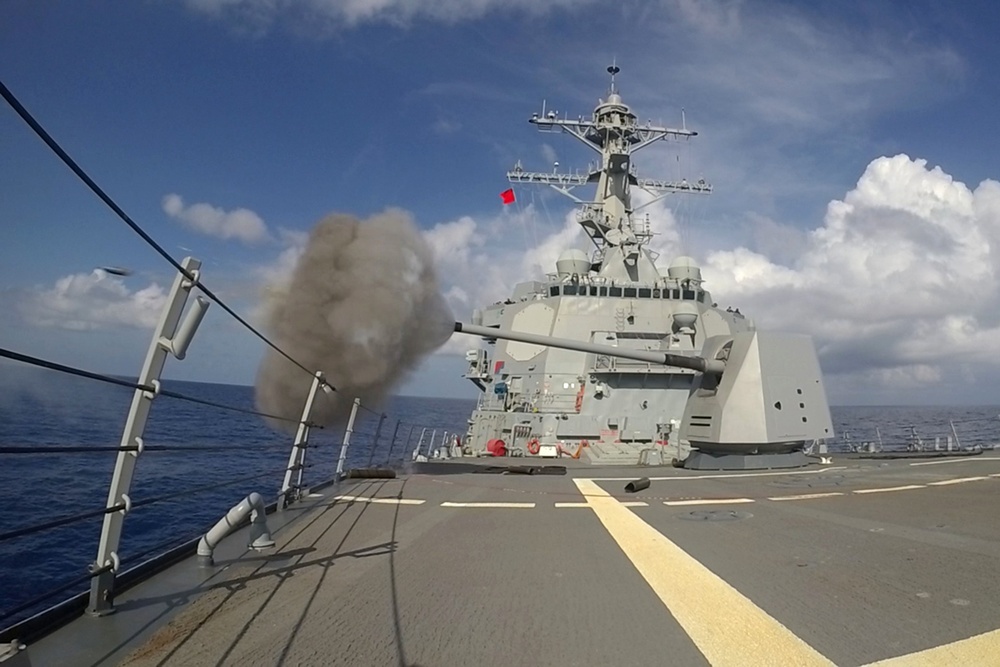
Making excellent time from the Marshalls to the target area, Task Force 58 was attacked by long-range enemy patrol bombers on the morning of June 11. This precaution became standard procedure for the fast carriers and was greatly expanded later in the war. With Mitscher’s approval, on the morning of June 11 I sent two destroyers fifty miles ahead of the force and a third one twenty-five miles. This incident prompted me to ask permission from Mitscher to station picket destroyers equipped with radar and fighter directors ahead of the group, with their own combat air patrol to detect enemy snoopers before they sighted the carriers. Land-based Liberators from Eniwetok preceded the carriers one of them shot down a Betty, but not before we overheard the pilot reporting our position.

We shot down the first snooper forty-seven miles from the task group, and a few minutes later splashed another. Ridgway dispatched a group of Hellcats to destroy them before they could sight the force and radio back our position to their base. “Snoopers” began to approach our combat air patrol on the tenth. On the night of the eighth, our radar registered several “bogies”-enemy search planes-but they never made contact with our force. My Task Group 58.1 left Kwajalein to rendezvous with 58.2 (Rear Admiral A. Task Force 58 sortied from its Marshall Islands bases on June 6, 1944, the landings on Saipan being scheduled for June 15. As he presented Clark with the award, Admiral Mitscher called him “my best carrier task group commander.” Jocko was one of Mitscher’s four group commanders in the Battle of the Philippine Sea, and he now tells his version of that crucial engagement in the following excerpt from his book Carrier Admiral, soon to be published by David McKay Co. Nimitz, when he introduced him to the 1945 American Legion Convention in Chicago as “the fightingest admiral of the fleet.” Clark’s proudest moment, however, came at a ceremony later that year when he received his second Distinguished Service Medal. Clark’s battle record in World War II was aptly described by the Chief of Naval Operations, Admiral Chester W. (Retired), an Oklahoma-born, part-Cherokee pioneer of naval aviation who commanded the new Yorktown before his promotion to rear admiral in 1944. Spruance (Mitscher’s commander during the Marianas operation), and the advocates of the fast carrier task forces. The escape of these ships prompted a round of bitter debate between the Navy’s “Gun Club,” composed of battleship admirals like Raymond A. Three Japanese carriers went to the bottom, but the rest of the enemy fleet fled out of Mitscher’s attack range. Mitscher’s Task Force 58 effectively destroyed Japan’s carrier air power.

The Japanese rose to the bait, and in the resulting, Battle of the Philippine Sea, the pilots of Admiral Marc A. objective was to seize Saipan and Guam and, in the process, to lure the remainder of the Imperial Navy into a death battle. The stage was thus set for a decisive naval confrontation at the Mariana Islands, only 1,500 miles from Tokyo. The Gilbert and Marshall Islands had fallen MacArthur’s forces were pressing relentlessly up the Bismarck Archipelago toward Rabaul, which Navy fliers had battered so hard that they had renamed it Rubble and, two months before, a surprise carrier attack had neutralized the Japanese stronghold of Truk. Navy had inflicted disastrous losses on the Japanese Imperial Navy and had seized control of the Central Pacific.


 0 kommentar(er)
0 kommentar(er)
